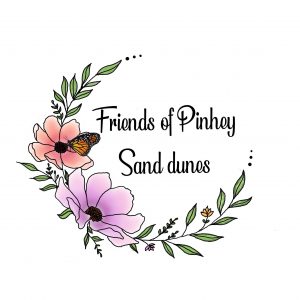Latest News and Notices from
Biodiversity Conservancy International
EcoTour – August 26, 2023
TOUR UPDATE: The tour will be on tomorrow (Aug. 26)
According to the Weather Network, the weather will improve from 7 AM, 40% <1mm 08/26/23
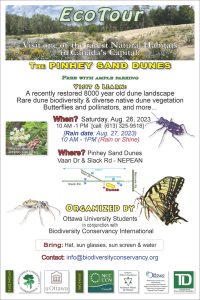
YEAR 2022
DUNE TOUR- August 27th, 2022 10am-1pm
Students from the University of Ottawa in conjunction with Biodiversity Conservancy International will be hosting a free tour of the Pinhey Sand Dunes on Saturday, August 27th, 2022, from 10am to 1pm.
Located at Vann Dr. and Slack Rd in Nepean, the Pinhey Sand Dunes are a special feature of the Ottawa region. The inland sand dunes host a unique ecosystem where many different insects and plants can be found. The tour will take you around the prehistoric landscape and will highlight the different Tiger Beetles that can be found on site as well as showing off butterflies that frequent the sand dunes. Overall, the tour will have a large focus on promoting the conservation of the sand dune habitat and biodiversity in Canada’s Capital.
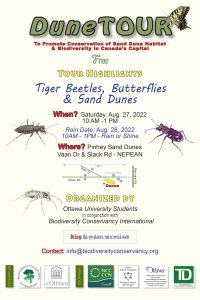
The Pinhey Sand Dunes, an open classroom for students from Carleton University
On September 17 and October 1, 2021, 2 groups of students (60 in total) in Environmental Science from Carleton University with professor William Twardek took a two day field trip to the Pinhey Sand Dunes (PSD) to participate in the On-Site Dune Education provided by Biodiversity Conservancy International (BCI).. During this 2 day trip the students had a hands-on opportunity to learn:
(i) one of the rarest inland sand dune habitats in Canada where a unique group of dune organisms inhabit;
(ii) the restoration and reclamation of natural sand dune habitats from parts of the red pine plantation in the National Capital Greenbelt;
(iii) the process of restoration of the PSD ecosystems, including the effort in enhancement of the genetic diversity of species at risk such as the Ghost Tiger Beetle (Ellipsoptera lepida), and the repopulation of sand dune vegetation;
(iv) the effort in the recovery of the extirpated and endangered Mottled Duskywing Skipper Butterfly (Erynnis martialis);
(v) the effort in the conservation of species that use the PSD for foraging (butterflies and other pollinators such as bees, wasps, flies, beetles…), and for hunting (dragonflies, robber flies…);
(vi) the process of restoration and maintenance of sand dune habitats by actually taking part in the dune work which is currently in progress, including removing saplings. alien invasive plant species, weeds… , accumulated organic detritus on dune surface, and sifting to separate sand from organic debris.
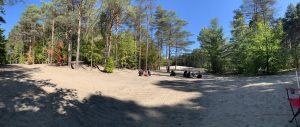
The field trip to the Pinhey Sand Dunes should give the students a different perspective on one aspect of the environment which is that planting trees causes adverse effects to the environment particularly with regard to natural habitats and ecosystems such as those of sand dunes.
A Call to Action by Carleton University Student, Neel Hebert
Come visit the Pinhey Sand Dunes! These dunes were created as a product of the Glacial Maximum and the Champlain Sea. Due to the creation of housing developments and tree plantations unfortunately only 1% of the area of these dunes are left. Come volunteer and help restore what little sand dunes we have left to protect insects and invertebrates such as the Tiger Beetle and the Milbert Robber fly that survive in this specific habitat. Why not see the butterfly Sanctuary while you are at it! This area is a restored section of the dunes where a variety of vegetation lives so you see many different types of creatures. Pinhey Sand Dunes biodiversity was almost completely lost if not for the habitat restoration project. Thanks to Biodiversity Conservation International the dunes are offering tours, education to universities and public schools as well as our previously mentioned butterfly sanctuary. This is a very special place where over 200 species of insects, invertebrates, shrubbery, and mushrooms rely on us to help protect them from the mistakes of people from the past. If you are lucky you may even spot toads, coyotes, snakes, dragonflies, and a great number of birds and more while you are hiking through. Come and help the cause!
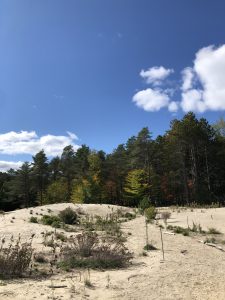
BCI Strengthens their Relationship with UOttawa
Beginning in Fall 2020, students from the University of Ottawa started volunteering at the Pinhey Sand Dunes. For the first time, students completed placements with our organization through the University of Ottawa’s Center for Community Engagement. The partnership successfully paired four students with BCI who each spent 30 hours helping with hands-on dune restoration work. The hours the students put in showed a drastic difference, especially at Site 3. The dune transformed from overgrown and grassy, to a pristine sandy habitat where the dune insects are able to thrive.
Images: Site 3 Before & After
 Site 3 Before
Site 3 Before

BCI was fortunate to have had help from an individual who went above and beyond: Emma White. Emma dedicated her time to the dunes out of her passion for nature and her eagerness for involvement. Even after the completion of her placement Emma decided to continue volunteering with BCI to help further promote conservation and the protection of this unique ecosystem. Emma manages to reserve some of her free time to work with the Friends of the Pinhey Sand Dunes where she contributes to the funding/grant area.
January 2021 brought a new set of students from UOttawa who have just recently completed their placements. This group of individuals have been helping with alternative tasks because the team is not capable of performing on-site work during the winter. The students during the winter have been spending their time helping with outreach for our virtual education program, working on creating content for social media, and planning events.
Here is what Clare Vais had to say about her experience volunteering with us:
“I got involved with BCI and the Friends of the Pinhey Sand Dunes through the Community Service Learning program at uOttawa. One of my fourth-year environment studies seminars gave us the option to complete 30 volunteer hours and write a reflection for class credit and I got placed with BCI. It has been an excellent learning opportunity, especially while school is happening virtually – it gave me the chance to learn about biodiversity in my community through practical experience. The team is lovely to work with and I’m so thankful to have been a part of it over these past four months!”
Collaborating with FPSD, the students planned and hosted a successful trivia night for the public on April 15th, 2021. There were over 20 registrants! The trivia focused on butterflies and pollinators and next month, FPSD will be hosting another trivia night about dune insects. Be sure to follow them on Instagram @pinheysanddunefriends and join the community Facebook group @Friends of Pinhey Sand Dunes to keep up on their latest projects.

Panels
On February 23rd & 25th UOttawa hosted UOttawa: Volunteering: A way into my community and the Job Market (English and French ). Our community liaison and volunteer coordinator Olivia Leon took part in both panels, alongside other very experienced panelists. Olivia discussed her involvement in volunteering over the years and how it helped her gain a job in the field of conservation. The panels together reached over 70 students and the information presented was well received based on the amount of questions that were asked during the question period.
Career Fair
On March 10th, 2021 BCI was involved in the UOttawa alumni and graduate virtual career fair. This fair gave BCI an opportunity to reach out to the public for volunteer recruitment. The platform that was used allowed the organization to share a wealth of information including video clips and posters. Members spoke to individuals over the course of a four hour session. BCI hopes to attend other career/ volunteer fairs with UOttawa in the future.
TD Environmental Leadership grant
Over the winter, our organization applied to the TD Environmental Leadership grant through UOttawa and was successful! This grant allows us to have a group of 10 student volunteers work on a specific project on site at the Pinhey Sand Dunes over the summer. The project will be focusing on the study of the behaviour of sand wasp and will include collecting data and summarizing the results leading to a publication in the internationally published journal Biodiversity. If you are a student attending the University of Ottawa, you can sign up to participate in this program on the community engagement navigator by searching the words: study of the behaviour of sand wasps. The project will begin in mid-June.
Clare Vais Reflects on her Experience
Volunteering with BCI has taught me so much about the diversity of the ecosystems in my community. As a student in social sciences at the University of Ottawa, I find that a lot of my courses talk about the intersectionality of the environment and various social, political, and economic issues, but I don’t typically get to focus specifically on biodiversity and restoration efforts. I’m in the last semester of my degree now and came across this volunteer opportunity in my International Development and Environment seminar. It has been an incredible experience as it helped me to further understand what I’ve learned about community-led environmental efforts. The fact that this restoration effort is in my own city made it even more interesting!
One of the best parts of my university experience was being involved in extracurricular activities. Throughout my time at UOttawa I had the opportunity to plan several social and academic events and do outreach and fundraising for a variety of campus clubs and organizations. Volunteering with BCI has allowed me to apply all these skills I’ve gathered in a different setting. Collaborating with the team to figure out how to engage our community despite having to operate virtually has been a challenge, pushing us to think outside the box. Our virtual trivia night event series has been in the making for a couple months now, and the first one is happening in just a few days. It has been great to see the team’s hard work come to fruition, and I’ve loved contributing my skills to the efforts to raise awareness about the importance of biodiversity at the Dunes.
Clare Vais- UOttawa CSL Placement
04/14/2021
—————————————————————
A Perspective on Conservation
When people think of sand dunes they may picture a desolate area devoid of life, but Pinhey Sand Dunes is quite the opposite! Yes, the dunes can reach temperatures in the summer of up to 72 degrees celsius, but many species have adapted to these harsh environments. These inland dunes are home to many insects and plant species that would face the potential of losing their home if conservation efforts are not continued. Conservation efforts at the sand dunes look a bit different than one might expect. Oftentimes we are taught that conservation means planting trees. Even though the Pinhey Sand Dunes are surrounded by trees, conservation at the dunes actually means removing the trees so the natural habitat of the dunes can be restored and the insects and plants that depend on the dunes can thrive. By removing one species of tree, we make room for over 200 species of dune dwelling organisms, mostly insects, spiders and other arthropods and dune plants! To restore the Pinhey sand dunes, some species of trees, such as the red (native) and the invasive alien scots pines planted in the 1950s, need to be removed so that there is room for other species that grow in the sand dune ecosystem to have a home. Ecosystems are diverse and therefore protecting and restoring natural habitats is also diverse. There is no one size fits all when it comes to conserving the biodiversity of our planet. Not only does the restoration of the Pinhey sand dune habitat save the dune ecosystem, but it also enriches the biodiversity and diversifies the habitats of the National Capital Greenbelt!
Sydney Walter – UOttawa CSL Placement
02/25/2021
——————————————————————
New Organization Partners with Community Groups with Young Leaders
The summer of 2020 opened new doors for Biodiversity Conservancy International (BCI), with a lot of publicity. Four months into the COVID-19 Pandemic, with lockdowns lifted and people getting antsy, Ottawa residents decided to become tourists of their own city and discover new natural areas where there is open space to socially distance, breathe fresh air, and get some vitamin D. If you search “Pinhey Sand Dunes Ottawa” in Google, the first page of results brings up blogs written in June and July by Narcity, Stephanie White Travels, Tapped out Travellers, and Macaroni Kid Ottawa, and this list continues onto the next page. This widespread advertisement got over thousands of visitors (estimated 4000-5000) to the Dunes over the summer, and allowed all those people to learn about who works to keep this unique ecosystem pristine and in existence.
In addition to these visitors, a number of volunteers joined BCI, from high school students looking to fulfill their community involvement requirements to post-secondary students looking to gain some hands-on experience. BCI saw these young, eager volunteers, and decided to act upon this and propose the formation of a “Friends of Pinhey Sand Dunes” (FPSD) volunteer group to work under the auspices of BCI. It began with meetings between some of the new volunteers and the founder of BCI; Dr. P. T. Dang. The goal for this group is to register as a non-profit group under BCI, secure funding through local grants, and train volunteers to maintain the Dunes, which includes weeding, raking debris, fixing fence lines, observing biodiversity and documenting species behaviours. We will also have a volunteer in charge of social media content, as well as volunteers focused on developing events to promote the sites for different age groups. We will always remind the FPSD that this group is for the community in perpetuity.
Today we have a strong, active group that will see that the Dunes are cared for by the best group of volunteers, and continue to spread the word to the public and schools in hopes of recruiting more young members.
As for BCI, our work on the dunes is progressing well. During the summer, we were able to host Girl Guides, Scouts Canada, and school groups for socially-distanced fun! Groups attended the Dunes for the day to get their hands dirty and help out with restoration. They sifted sand to remove debris; cleaning it and making ideal habitat for the organisms which rely on this ecosystem. They also got to connect with the insects that live in the dunes by observing their behaviour and letting them crawl on their hands.
As we transition into the winter season, physical labour at the dunes has stopped and we have been focusing our time on developing streamlined virtual tours, including different information to appeal to every age group. BCI has a sub-group dedicating their time to reaching out to schools and learning the material so they can present these virtual tours in an engaging and exciting way!
Kyra McKenna – Friends of Pinhey Sand Dunes Committee Secretary
——————————————————————-
The Urban Botanist Interviews Pete Dang – November 13th, 2020
——————————————————————-
PLANTING with Lucas Teeft – September 24, 2020, 10am Dunes 2
Join Lucas Teeft, planting and design specialist, at the Pinhey Sand dunes to learn about proper planting procedures for sandy areas and plants that are great for attracting pollinators.
Lucas is a Carleton University graduate with a BA in Environmental Studies. He is passionate about developing creative solutions to problems that can be found in the urban realm.
View his LinkedIn profile here:
https://www.linkedin.com/in/lucas-teeft-6bb21461/?originalSubdomain=ca&fbclid=IwAR3gyISmWq9cH-kJupBjXuPN2kY4qbqmd8PF1AyIazGGsjFDoAVkDXY7F30
——————————————————————-
Pinhey Sand Dunes Butterfly Sanctuaries (PSDBS) – Committee Meeting: October 9, 2019, NOON at Dunes 2.
Brainstorming Meeting October 9, 2019
- Attendants:
Catling, Paul Ph.D. (Botanist); Dang, P.T. Ph.D. (Lepidopterist); Erickson, Berit (Butterfly Gardener); Douglas, Hume Ph.D. (Coleopterist); Goulet, Henri Ph.D. (Hymenopterist); Gill, Bruce Ph.D. (Coleopterist); Gill, Jocelyn (Biologist) Kostiuk, Brenda (Biologist); McFetridge, Robert (Biologist)
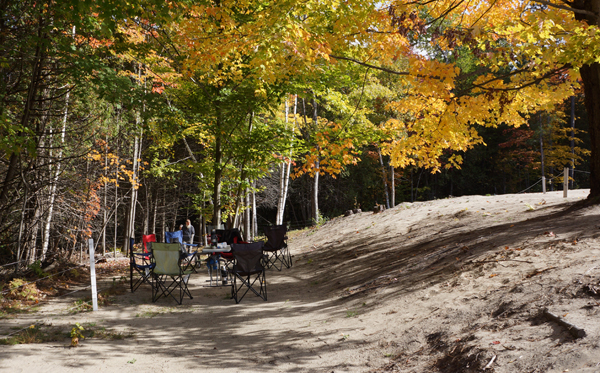
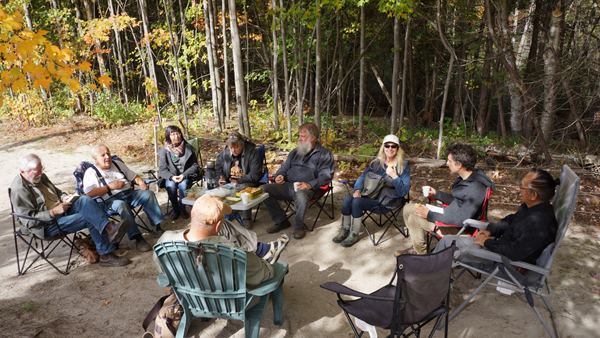
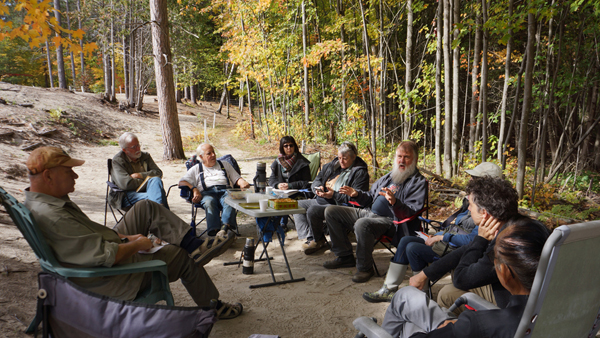
Butterfly Sanctuary Brainstorming Meeting Minutes
Attendees:
Paul Catling, P.T. (Pete) Dang, Hume Douglas, Berit Erickson, Bruce Gill, Jocelyn Gill, Henri Goulet, Brenda Kostiuk, Bob McFetridge, T.D. (Thu) Trinh. Unable to attend: Peter Hall
Pete Dang welcomed the group to the
Pinhey Sand Dunes on a beautiful, sunny afternoon at the Pinhey Sand Dunes 2
<http://www.biodiversityconservancy.org/news-html>
Pete started
the meeting with a brief description of the Biodiversity Conservancy
International (BCI)’s successful collaborative effort with the National Capital
Commission (NCC) in restoring parts of the Pinhey Sand Dunes System (PSDS). To date, 3 dune sites, namely Dunes 1, Dunes
2 and Dunes 3, have been restored (from densely planted forests) with a total
reclaimed open dune space of over 20,000 square meters. In addition, Hydro One (HO) has approached
BCI and proposed the Hydro Corridor between Grenfell Cres. and Slack Rd. (HOGS)
near Dunes 3 be kept as another dune site after HO’s tree clearing operation in
the HOGS is completed. According to the
1925 aerial mosaic photo of the areas, the HOGS lies within the PSDS, and will
be known from now as Dunes 4. Including the HOGS, the total combined restored open
dune space in the PSDS is approximately 30,000 square meters.
Pete
noted that it has been observed that butterflies and other none dune insects
have used the newly available open space for foraging and hunting. These include
several species of butterflies, parasitic and predaceous flies, and a good
number of species of dragonflies, bees &wasps,…During the 2019 growing
season, many Monarch caterpillars were found on nearly every protected milkweed
patch in Dunes 2 from May to early October; and the Monarch adults were among
the most common and showy insects seen in Dunes 2 and 4.
Given the
newly reclaimed treeless dune environment, suitable for a wide range of dune
and non-dune insects, BCI is prepared to extend its primary conservation of the
sand dune ecosystem to undertake an additional effort in creating a sanctuary, encompassing
all restored dunes sites, for the protection of butterflies and other insects,
particularly species at risk and those that have roles in ecosystem services.
The sanctuary is tentatively named as the Pinhey Sand Dune Butterfly Sanctuary
(PSDBS).
Pete indicated
that the NCC is very interested in the Butterfly Sanctuary idea. They are also interested in pollinating
insects being part of the sanctuary.
The first topic of discussion is how to make dune visitors (i.e., non-dune insects), become dune residents. The group agreed that introduction of a variety of natural native sandy tolerant butterfly host and nectar plants to provide food and some shelter are the answer.The edge of the forests surrounding the dunes also serves as a great shelter for most insects. Paul and Brenda will provide a list of native plant species inhabiting sandy areas to be introduced to the restored parts of PSDS as butterfly host and nectar plants. Berit suggested all members start collecting seeds as they are readily available this time of the year so they can be germinated and planted in the spring.
The
second topic of discussion is that the BS should focus on species at risk. The
effort in the re-introduction of extirpated butterflies such as the Karner Blue
(KB) should be on the PSDBS action list.
It is suggested that the KB’s host plant (wild lupine) should be
introduced to the Pinhey Dunes as soon as possible in order to create a decent wild
lupine population which can sustain the KB once it is re-introduced to the
dunes.
Before
the meeting was adjourned, Pete confirmed the Pinhey Sand Dunes Butterfly Sanctuary
Committee has been formed including all attendees at this
meeting. The committee will expand to
include several additional members (butterfly specialists and interested people
from local organizations),
——————————————————————-
Life on Earth Workshop – May 4, 2019
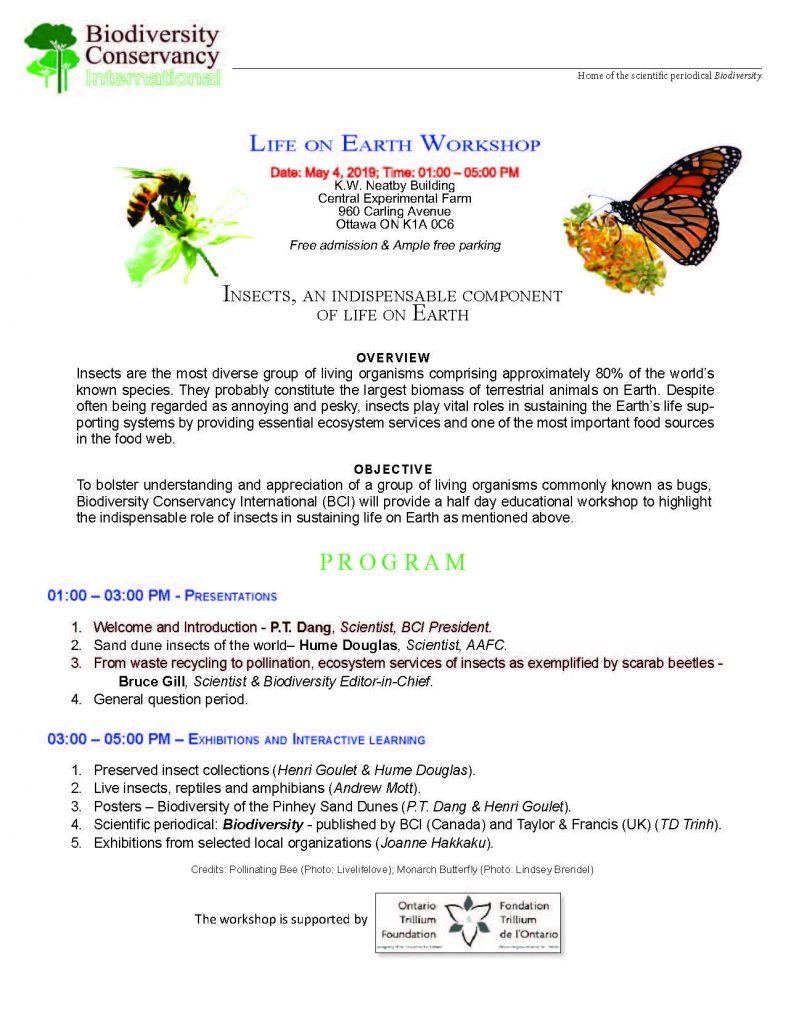
Pinhey Sand Dunes Poster Contest
| Top 3 Winners |

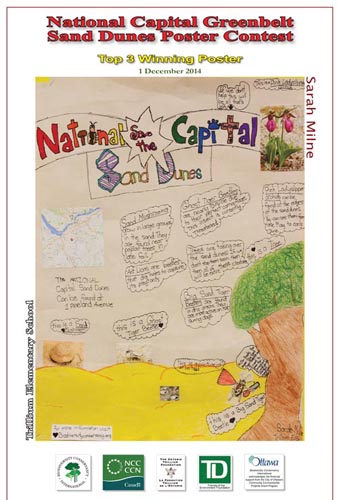
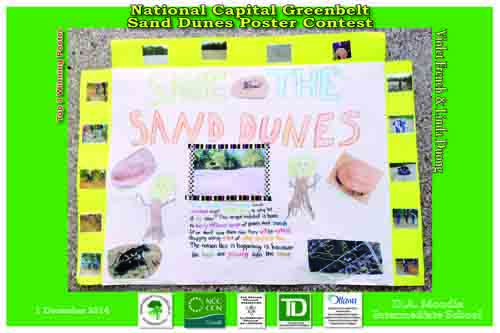
Media Coverage
Media coverage
on Biodiversity Conservancy’s programs
CBC News
Posted: Sep 03, 2013 9:13 AM ET
Rare, ancient Ottawa sand dune at risk
Volunteers needed to help Pinhey Sand Dune ecosystem survive
Blog Radio interview with Executive Secretary Stephen Aitken on “From the Top – The UN Decade on Biodiversity”
Listen to internet radio with DrCal3 on Blog Talk Radio
October 25, 2012
Sand dunes get stewards,
Conservationists form group to protect
Nepean’s unique landform
Article, By Jennifer McIntosh
EMC news – Conservationists that beat back the forest to reclaim an inland sand dune near Slack Road announced they will remain on guard.
The group of residents, scientists, local politicians and staff from the National Capital Commission met on Oct. 18 at the newly-dubbed Pinhey Sand Dune for the inauguration of the Stewards of Sand Dunes (SOS-Dunes).
The conservation effort received a $100,000 boost from the Ontario Trillium Foundation in June 2011 to be handed out over two years.
“It’s amazing the work that has been done with that grant,” Nepean-Carleton MPP Lisa MacLeod.
The dunes were formed by movement of the ice, during the last ice age, which started to recede approximately 10,000 years ago. Over the past 60 to 70 years in eastern Ontario, the dunes have declined to only one per cent of their natural coverage.
This is a concern because they are home to as many as 65 regionally-rare species of plants and animals.
One such animal is the ghost tiger beetle – a 12-millimetre long insect the same colour as the fine-grained sand and whose only home in Ottawa is the dunes on Slack Road.
If that system isn’t preserved, the species will become extinct in this region.
The group worked with aerial images of the area over the last 75 years to track some of the damage, then removed plants, weeds and trees to reclaim some of the area.
Dr. P.T. Dang, president of Biodiversity Conservancy and one of leaders in the conservation effort, said the group is very grateful to the community for all their help.
“We had children from local schools here, learning about biodiversity and helping out,” he said.
Now that the area has been reclaimed it will be up to volunteers with the SOS-Dunes to keep an eye on the area to prevent the trees from encroaching on the rare habitat.
Dr. Henri Goulet, an entomologist who used to work at the Experimental Farm has been combing the area for nearly 30 years, getting an up close look at the habitat of the rare insects.
“I came here to see the white tiger beetles and fell in love with this place,” he said.
The surface temperature of the sand on the Pinhey Sand Dune is 70 C. The beetles burrow under the surface. The anthrax – or “bee fly” – come along and drop their eggs holes in the fine-grained sand.
“There are creatures here that can’t be found in the surrounding forests or the neighbouring lawns,” Goulet said.
Now the dunes have been restored to some of their former glory, the stewards and the National Capital Commission – will become caretakers and put up signage to educate the public about the ecology.
Knoxdale-Merivale Coun. Keith Egli said the area gives him bragging rights around the council table.
“It’s an incredible example of biodiversity and a great example of community,” he said. “Three levels of government came together, along with residents and other volunteers.”
Gynn Norman, a resident of Merivale Gardens – the community that surrounds the dune, said the experience has been great for her children.
“My son’s favourite thing to do in the morning during the summer is go out and talk to his retired friends,” Norman said, recalling a time when her son tried to beat Dr. Andrew Mott up a tree.
Eva Katic, an NCC manager for natural resources and land management within the Greenbelt, said the call from Dr. Henri Goulet asking if they could go in and do conservation was like winning the lottery.
“It’s very rare that we get calls from scientists wanting to do conservation work,” she said. “In 14 months the sand dune has doubled in area and it has become a catalyst for community involvement. It’s a great opportunity to preserve the ecology and for research.”
Original EMC Nepean-Barhaven News article
Note: This article also appeared in yourottawaregion.com

October 18, 2012
Ottawa’s suburban sand dune
Article, Tony Spears, Capital City News
After a few thousand years, even the hardiest sand dune needs a little help from its neighbours.
And the sand dune tucked into the forest near Slack and Merivale roads needs more help than most.
It is of that most rare species: the suburban sand dune. Utterly landlocked, without so much as a brook to babble at, the Pinhey dune is slowly being eaten up by encroaching woods.
“This one’s about 12,000 years old, it’d be formed during the last glacial retreat,” said Stephen Aitken, project co-ordinator with the Pinhey Sand Dune Conservation Project. “It’s the sand from the Champlain Sea.”
The Champlain briny covered the Ottawa Valley once upon a time before the sea slunk back to the Atlantic Ocean, leaving a sandy floor behind.
“The inland dunes were the remnants of that sea” Aitken said. “The Pinhey Forest is all underlain by sand as well.
Original sand
“This is one of the last remaining little areas of that original sand.”
To fight back against pernicious vegetation, the dune’s allies have received a provincial grant and help from the National Capital Commission, which has already removed a number of trees.
“We figured in about five years that dune was going to be gone,” Aitken said.
Concerned citizens have also formed the aptly named Stewards of Sand Dunes group — or SOS Dunes — which will officially be launched Oct. 19.
The NCC and the Biodiversity Conservancy have granted the group permanent stewardship over Ottawa’s dunes.
The Pinhey dune supplies suitable condition for the finicky, delicate Lady’s Slipper orchid, but it is also home to fearsome horrors.
Ant lions look a bit like tiny armadillos, except that they have massive mandibles that clamp down on their prey, who don’t know what’s happening until it’s too late. They dig out small conical depressions in the sand that look innocuous, but when an ant wanders in it transforms into a hell pit.
That’s because the ant lion has buried itself at the bottom, mandibles poised at the centre of the depression.
Ant lion
The ant lion seizes its prey to drag into its maw; if it misses the ant can try to scale the sides of the pit to escape — but the fine sand prevents it from getting good footing and it will inexorably fall back into the jaws of its pitiless killer.
Aitken hopes to expand the dune’s foot print to three or four times its current size.
“It’s history in Ontario from the last Ice Age,” he said.

July 27, 2012
Canadian Youth Volunteer at Sand Dunes
Article, Ward 9 Newsletter, Councillor Keith Egli
On July 23, 12 youth and three adult leaders from all across Canada arrived in Ottawa to work with local conservation group, Biodiversity Conservancy, to save and protect the rare inland Pinhey Sand Dune ecosystem located within the National Capital Greenbelt.
As part of their 2012 focus on leadership and sustainability, the Children’s International Summer Village (CISV) youth joined in the effort to create awareness of this conservation project, identifying and cataloguing endangered insects, and clearing encroaching vegetation to restore this unique habitat.
Councillor Egli was on site to welcome the youth and help search for ant lions and other insects. “Over the past year we restored a large, core dune with the help of the local community and many dedicated volunteers,” said Stephen Aitken, project coordinator of Biodiversity Conservancy. “This rare ecosystem harbours many unique organisms and this year, with the collaboration of the NCC and a new generation of enthusiastic volunteers, we hope to recapture more of the original sandy dune habitat.”
For information: www.tc-biodiversity.org/.
Download Newsletter pdf (750kb)

August 8, 2011
Digging dune to save doodlebugs from ruin
By Joe Lofaro, Metro Ottawa
Few people know that Ottawa has a rare, desert-like ecosystem near Woodroffe Avenue ‘ even though it’s been there for nearly 10,000 years.
The Ottawa Greenbelt Sand Dune is home to many unique species but it’s slowly disappearing because of encroaching vegetation, such as trees and small plants. A group of scientists and volunteers is trying to preserve it by removing the trees that were planted there to open up the area and keep it hot and dry.
One threatened species is the antlion, which survives by building traps in the sand to capture ants.
“The sand dune is the result of the last ice age,” said Tropical Conservancy president Dr. P.T. Dang, who is leading a two-year preservation project. “If we remove this (sand dune) habitat, animals that live here are going to be lost forever,” he said.
Grade 12 students from Merivale High School and other members of the community have been volunteering on weekends to uproot trees and other vegetation.
“It’s difficult work but it’s really satisfying because you can see the progress,” said Anish Muradia, 16. “It’s a really unique feature of our area,” added Rahul Chandan, 17.
Read the article online (includes photos)

August 5, 2011
Local youth work to save rare in-land sand dunes in Ottawa
By Vani Edwardson, Blog Post, Transition Ottawa
Ottawa’s Children’s International Summer Village (CISV) today announced a partnership with local conservation group, Tropical Conservancy, to save and protect a rare in-land Sand Dune eco-system within the Ottawa Green Belt near the corner of Woodroffe ,Slack road and Vaan. As part of their 2011 focus on sustainability, CISV youth will join in the effort to create awareness of this conservation project, identify and catalog endangered insects, and clear invasive vegetation to restore this unique habitat. More at Transition Ottawa . . .

July 15, 2011
Rare Slack Sand Dune under threat
CBC News
Local conservationists keen to save Ottawa’s last inland sand dune are digging up invasive species plants that pose a threat to a rare unique ecosystem and remnant from the last Ice Age.
High-school students armed with rakes and shovels removed plants at the sand dune off Slack Road in Nepean on Friday, in an effort to restore the shrinking habitat.
The Nepean sand dune — the largest in Ontario — was created when the glaciers retreated some 10,000 years ago.
Stephen Aitken, the project co-ordinator for the Ottawa Greenbelt Sand Dune Conservation project, said the Slack Sand Dune is in danger of being lost unless there’s some intervention to remove invasive plant species.
“Ontario is down to one per cent of the sand dunes that they used to have, and they are a vital part of Ontario ecosystems and Ontario life.”
NCC vows dune will be protected Dr. Henri Goulet, a retired entomologist who worked with Agriculture and Agri-Food Canada for 33 years, said there were some insects that still remain unique to the dune’s ecosystem.
“We’re losing a unique fauna that is not found in your backyard, that is not found in marshes,” he said. “It’s only found in this type of habitat.”
Artile continues online at cbc.ca

June 12, 2011
Nepean conservancy group gives nature a helping hand
By Jennifer McIntosh, YourOttawaRegion.com
Trillium Foundation grants $100,000 for protection of rare land form
A group of Nepean-based conservationists are giving nature a helping hand.
Ottawa Greenbelt Sand Dune Conservation — an offshoot of Tropical Conservancy —has received a $100,000 grant over two years from the Ontario Trillium Foundation to support their efforts in reclaiming the habitat of the shrinking sand dunes in the forest behind Slack Road.
Stephen Aitken, who is coordinating the project with Tropical Conservancy, said the dune is the last one of its kind in the city — and one of a rare few in the province.
“Sand dunes are more associated with beach areas, but inland dunes are very rare,” he said, adding that the area is a couple of football fields long as well as wide.
The danger is the surrounding forested area has begun to encroach on the dunes with trees and other invasive species moving in.
With the help of volunteers from the Merivale Gardens Community Association and the students at Merivale High School, Aitken said he hopes they can re-establish the area by removing the trees and plants and then returning them to the forested area.
“We had some kids come and help pull some poplar balsam, blackberry bushes and buckthorn shrub,” he said, adding that younger kids from the community were sifting through sand to remove the organic matter.
The group is working with aerial and satellite images of the area over the last 75 years to track some of the damage.
The dunes were formed by movement of the ice, during the last ice age, which started to recede approximately 10,000 years ago. Over the past 60 to 70 years in eastern Ontario, the dunes have declined to only one per cent of their natural coverage. This is a concern because they are home to as many as 65 regionally-rare species of plants and animals.
One such animal is the ghost tiger beetle — a 12-millimetre long insect the same colour as the fine-grained sand whose only home in Ottawa is the dunes on Slack Road.
If that system isn’t preserved, the species will become extinct.
Aitken said the NCC has been very supportive of the group’s efforts and will work to put up signage to discourage bonfires and other practices that may damage the dunes.
He also said a community-level group will be set up once the two-year grant period is completed to make sure the area is maintained.
“Once we return it to its former glory, it should be pretty easy to maintain,” Aitken said.
The group plans to hold workshops and visit school to educate residents on the rare eco-system.jennifer.mcintosh@metroland.com
Ottawa This Week-Nepean

June 9, 20211
Group hopes to save rare Ottawa landform
(EMC Nepean/Barhaven Article)
EMC News – A small but dedicated group of conservationists are planning to save a rare piece of geology in Nepean from being swallowed by encroaching nature.
Hidden from the public’s view in the woods off of Slack Road is the only example of a naturally occurring sand dune ecosystem in Ottawa, a remnant of the retreat of the last Ice Age. The formation is in danger of disappearing entirely due to the spread of invasive (non-naturally occurring) plant species that were introduced to the Greenbelt decades ago.
Ottawa Greenbelt Sand Dune Conservation, a subgroup of Tropical Conservancy, has recently received a two-year Ontario Trillium Foundation grant to reverse the loss of habitat and restore the shrinking dunes.
Tropical Conservancy is an Ottawa-based (and registered) charitable scientific organization that publishes the scientific journal Biodiversity, the subgroup was formed in March of this year to target the threatened piece of land.
“It’s the last remaining visible sand dune in Ottawa,” explained project coordinator Stephen Aitken. “The area is a couple of football fields long as well as wide. Nature has moved in and is basically reforesting it.”
With the grant money, the group aims to enlist the help of volunteers as well as the National Capital Commission in removing the invasive plants, putting protective measures in place, and educating the community on the area’s significance.
Already they have brought students from Merivale High School to visit the ecosystem, while workshops are planned for the coming months to introduce the wider community to the project and their intentions.
The Slack Sand Dune, much like the Burnt Lands alvar to the west of the city and the Mer Bleue bog to the east, is an example of an unique ecosystem existing in isolation far removed from its natural habitat. The glaciation of 10,000 years ago is responsible for the creation of each of these examples.
However, unlike Mer Bleue and Burnt Lands, the dune is smaller, more vulnerable, less known and currently unprotected.
Being a scientific organization, the group plans to write a scientific paper on the area, and are planning a species inventory of the area with the help of biologists.
The dune is home to the Ghost Tiger Beetle, a half-inch long insect the same colour of the fine-grained sand that risks becoming locally extinct if the destruction of the ecosystem continues to erode.
It will be the NCC’s job as the regulatory body overseeing the Greenbelt to put signage and access measures in place to limit the more destructive of human practices, such as bonfires (a bad idea as it is) and four-wheeling.
“The NCC is very invested in our project,” said Aitken. “They’ve wanted to restore it but didn’t have the scientific expertise.”
He added the removal of invasive plants will undo much of the damage of well-meaning planters from decades past.
“We’re giving nature a helping hand – earlier planters didn’t understand the ecosystem at the time.”
Information on the workshops will be forthcoming, following the project, a community-level group is expected to be formed to maintain the area into the future.
swillems@theemc.ca

